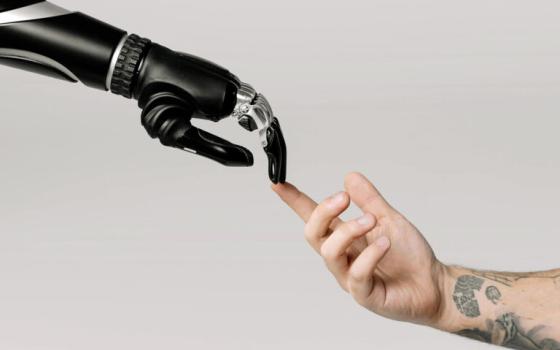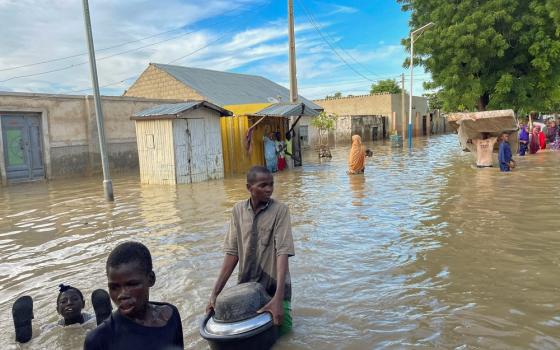Obama won among 'all Catholics’; McCain won regular churchgoers
As the election of Barack Obama is slid under the microscope, it’s already clear that Catholics played a significant and complex role. According to exit polls, those who identified themselves as Catholics voted for Obama 52 to 45 percent, a seven-point improvement for the Democratic candidate from the elections in 2004. That is the largest shift this election of any religiously affiliated group.
But does it represent a sea change in the Catholic political consciousness? Not necessarily, says John Green, senior fellow in religion and American politics at the Pew Forum on Religion & Public Life.
“It really doesn’t look to me like a realignment,” Green said in a media conference call Nov. 4. “I see this as a variation on the existing themes. We see the same structure. It’s just that Obama made this work for the Democrats.”
He was referring to the larger religious landscape, but was including Catholics in that equation. As much as anything, it appears an infusion of non-white voters from all religious points of view made the difference for Obama.
The bishop factor
Still, Catholic commentators saw the Catholic vote as a repudiation of certain bishops who warned that voting for Obama, a proponent of keeping abortion legal, could constitute a grave sin.
 “Catholic voters ignored the instructions of a group of vocal bishops,” Jesuit Fr. Thomas J. Reese wrote in a post-election news release for Woodstock Theological Center where he is a senior fellow. “Although these bishops were a minority of the U.S. bishops, they received much attention in the media because other bishops kept silent or simply referred people to their 2007 document, Forming Consciences for Faithful Citizenship.”
“Catholic voters ignored the instructions of a group of vocal bishops,” Jesuit Fr. Thomas J. Reese wrote in a post-election news release for Woodstock Theological Center where he is a senior fellow. “Although these bishops were a minority of the U.S. bishops, they received much attention in the media because other bishops kept silent or simply referred people to their 2007 document, Forming Consciences for Faithful Citizenship.”
One could argue that the results seem to better reflect the overarching message of the Faithful Citizenship document, which allowed for the possibility of justifiably voting for a pro-choice candidate if enough other grave issues outweighed the “intrinsic evil” of abortion.
But Gregory A. Smith, research fellow at the Pew Forum on Religion & Public Life, said American Catholics simply don’t see the abortion issue the same way that bishops do.
“One of things you have to keep in mind about Catholics is that most aren’t opposed to abortion,” Smith said. “And of those who are, most don’t see it as a particularly important issue.” Smith said a recent Pew survey showed that fewer than one in four Catholics said they oppose abortion and see it as a politically important issue.
Reese said a plethora of factors can explain Tuesday’s outcome.
“For Catholics, as for other Americans, the economy became the dominant issue in the election,” wrote Reese. “Few said that abortion was the most important issue. In addition, the anti-immigrant rhetoric from the Republican base chased Hispanics away from the Republican Party. Joe Biden, an experienced Catholic senator with working-class roots, helped the top of the ticket with Catholics much more than did Sarah Palin, the ex-Catholic evangelical governor of Alaska” [and Sen. John McCain’s running mate.]
Jim Wallis, editor of the progressive evangelical Sojourners magazine, sees a coalition forming based on the whole of Catholic social teaching, whether the person is Catholic or not. When these people see bishops speak out on just one or two issues, such as abortion and gay marriage or stem-cell research, he says the motive is obvious.
“It appears transparently partisan,” Wallis said. “It’s hard to respect somebody’s consistent ethic of life when they only talk about abortion and not the wars in Iraq and Afghanistan, poverty, genocide.”
Reese pointed to new groups pushing for a broader perspective on Catholic teaching, such as Catholics in Alliance for the Common Good, as having a positive effect on broadening this year’s political discussion. But he was somewhat pessimistic about what does get a Catholic to vote.
“A closer look at the exit polls should be as discouraging for left-wing Catholics as for right-wing Catholics,” Reese wrote. “Catholic voters did not embrace either the conservative nonnegotiables or the church’s preferential option for the poor. They were concerned about themselves and their families.”
Whatever the reason for their vote, Catholics once again proved to be a key to the White House. (The one recent exception was in 2000, when Democrat Al Gore won the Catholic vote but lost the in Electoral College.) Does this mean many Catholics changed their minds over four years? That clearly did happen to some degree, but other factors may have played a larger role.
Nonwhite Catholics
A majority of white Catholics preferred McCain, 52 percent to 47. Still, Obama made significant strides from the performance of Catholic Democratic candidate John Kerry, who took just 43 percent of the white Catholic vote in 2004. How much of that addition came from young white Catholics and first-time voters remains to be seen.
What seems more evident is that nonwhite Catholics, and especially Hispanics, drove the victory for Obama among the denomination. One way to know this: The percentage of Catholic voters remained the same from 2004 to 2008, but the number of white Catholic voters dropped 1 percent in that time.
Polling on Latino Catholic voting patterns is not yet available. But roughly 68 percent of Latinos are Catholic currently. So a look at the larger Latino vote in 2008 will provide some idea of its Catholic impact.
Obama took 67 percent of all Hispanic voters, a 16 percent improvement over Kerry. On top of that, Hispanics grew from 8 percent of the electorate in 2004 to 9 percent this year. According to the New Democrat Network, Hispanics were the key constituency for Obama’s wins in Florida, Colorado, Nevada and New Mexico, all states that voted for President Bush in 2004.
“[Hispanics are] a constituency that is still in play,” said Luis E. Lugo, director of the Pew Forum on Religion & Public Life, “but it is turning decidedly Democratic.”
The attendance split
Pew research also finds that the white and nonwhite Catholic categories no longer provide a fine enough distinction. Another distinction is the Catholics who regularly attend Mass versus those who do not. Looking at raw data on overall service attendance, Pew researchers said, provides a guideline.
Obama, as have other Democrats in the past, still lost to McCain among people who attend religious services regularly, but he did better than Kerry. Among those who attend once a week or more, McCain won 55 percent to 43 (Bush won 61 to 39). Among those who attend church a few times a month or less, Obama drastically turned the tables -- he won 57 percent to 42, a four percent increase over Kerry. And of those who never attend services, Obama won 67 percent to 30, a 5 percent increase.
In fact, the largest increase of votes for Obama over Kerry came among those who claim no religious affiliation. Obama took 75 percent of the vote from this constituency, an 8-point increase over Kerry.
Pew research suggested that two coalitions may be solidifying, those who attend religious services regularly made up 39 percent of the electorate this year -- and they vote largely Republican. Those who attend rarely or never make up 44 percent -- and they vote largely Democrat.
The 15 percent who attend semi-frequently, but not weekly, may prove to be the key swing voters. (Good luck finding them, candidates.) Last election, Kerry won that group 50 to 49. This time Obama won 53 to 46, an increase of approximately 2 million votes from that group alone.
“The fact that these gaps persist … tells us how important religion is to political values and the decisions that Americans make,” Green said. “But the politicization of religion is highly variable.”
(Michael Humphrey is a Kansas City, Mo., free lance writer.)


